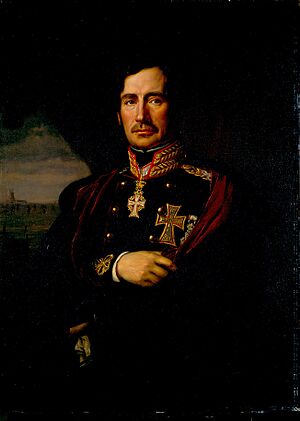Christian de Meza facts for kids
Quick facts for kids
Christian de Meza
|
|
|---|---|

Painting by Heinrich August Georg Schiøtt in 1860
|
|
| Birth name | Christian Julius de Meza |
| Born | 14 January 1792 Helsingør, Denmark |
| Died | 16 September 1865 (aged 73) Copenhagen, Denmark |
| Buried |
Garrison Cemetery, Copenhagen
|
| Allegiance | |
| Service/ |
|
| Rank | General |
| Battles/wars | First War of Schleswig Battle of Isted Second Schleswig War |
| Relations | Christian Jacob Theophilus de Meza (father) |
Christian Julius de Meza (born January 14, 1792 – died September 16, 1865) was an important general in the Danish Army. He led the army during the Second Schleswig War in 1864. General de Meza made a tough decision to pull his troops back from a strong defense line called the Danevirke. This decision surprised many people in Denmark and caused him to lose his command.
Contents
Life and Military Career
Christian Julius de Meza came from a family with Sephardic roots. He was a respected soldier and served well in the First War of Schleswig.
Role in the First Schleswig War
In 1850, de Meza played a key part in the Danish victory at the Battle of Isted. This battle was the biggest one in Scandinavian history at that time. His actions helped Denmark win this important fight.
Leading the Army in 1864
In 1864, General de Meza was chosen to be the top commander of the Danish forces. His main goal was to protect Denmark's border. He faced a much larger army made up of soldiers from Prussia and the Austrian Empire.
At 72 years old, de Meza was quite old for such a big task. The war also started in winter, which made things even harder for his troops.
The Danevirke Withdrawal
General de Meza realized that his soldiers were likely to be defeated. He believed that staying would lead to many unnecessary deaths. So, on the evening of February 5, 1864, he sent a telegram to the War Ministry. He told them that the army was getting ready to move back to a new position at Dybbøl.
To make sure his order was followed, he then cut off the telegraph line. This stopped anyone from trying to change his mind.
Aftermath of the Withdrawal
The decision to withdraw made the Danish government very angry. On February 7, they quickly removed de Meza from his command. This happened even while the army was still setting up defenses at Dybbøl.
He was officially dismissed on February 28. Although he became a general again on August 5, he did not fight directly in the war anymore.
Why the Withdrawal Was Important
Looking back, many historians agree that de Meza's withdrawal was done very skillfully. Even though some cannons were left behind, the Danish army reached their new position almost unharmed.
Historians believe that if the army had not pulled back, the Danevirke defense line would have been completely taken over. A special group set up by the government to investigate the withdrawal also cleared de Meza of any blame. Their report, issued on March 10, 1864, instead blamed the War Ministry for not being prepared enough.
General de Meza passed away a few months after the war ended.
See also
 In Spanish: Christian Julius de Meza para niños
In Spanish: Christian Julius de Meza para niños
- Evacuation of Danevirke

